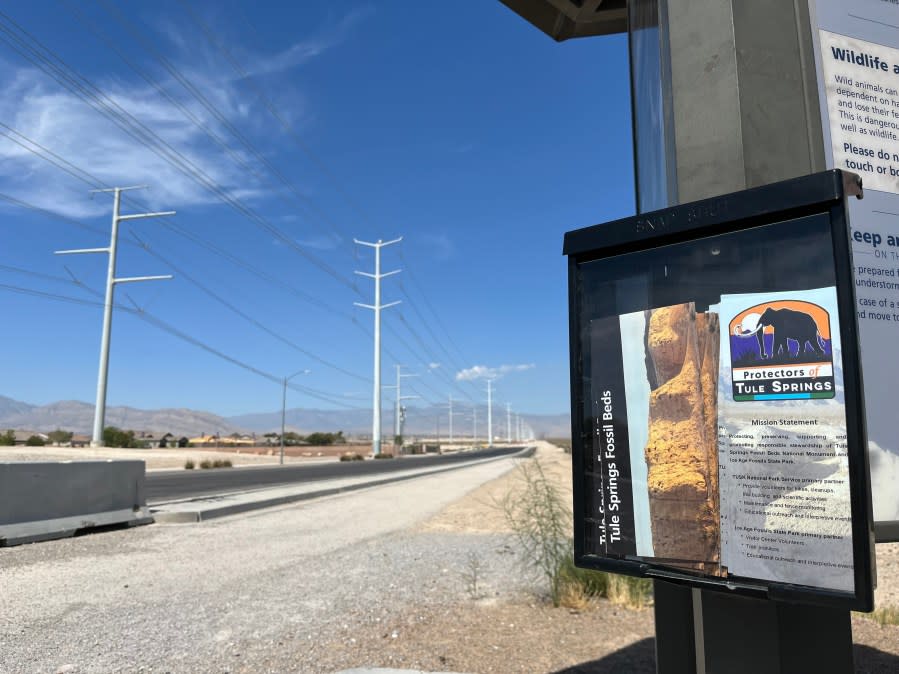Gold mine dodges Greenlink, but power lines still set to encroach on sensitive Tule Springs Fossil Beds
LAS VEGAS (KLAS) — Conservation groups are questioning the Bureau of Land Management’s “skewed priorities” in decisions surrounding the path of a massive powerline project between Las Vegas and Northern Nevada.
Email exchanges between BLM officials and the leader of Basin and Range Watch, Kevin Emmerich, indicate that the Draft Environmental Impact Statement (DEIS) for Greenlink West has been delayed after initial plans to release it on May 10. The $2.5 billion NV Energy project is a key component of infrastructure to produce solar power on BLM-controlled land in Nye and Esmeralda counties.
In a Tuesday news release, Basin and Range Watch, along with Public Employees for Environmental Responsibility (PEER), suggested that BLM cares more about private mining claims than about potential damage to prehistoric fossils within the borders of Tule Springs Fossil Beds National Monument.

NV Energy’s lines will require the expansion of an existing transmission corridor along Moccasin Road, which is on the southern border of the national monument. A total of 11 new power poles, each with a 100-square-foot concrete footing, would encroach on that border — possibly running into fossils that have been embedded in sediments for 12,500 to 100,000 years.
The claims held by AngloGold Ashanti are near Beatty, about 120 miles northwest of Las Vegas.
“It is disappointing to see the BLM work so hard to make a gold mining company happy but fail to take reasonable measures to protect irreplaceable paleontological resources,” Emmerich said. “Our national park lands have never been more cherished by the public and the BLM must take measures to ensure that these lands are protected for future generations.”
Emmerich spent 20 years with the National Park Service in seven different national parks and monuments, including Death Valley. His group is known to take more extreme positions on environmental issues than better-known mainstream groups.
PEER is moderate in comparison, but their statement was no less critical.
“If BLM can reroute this corridor to avoid interfering with exploration for gold, it can surely do the same thing to avoid the almost certain destruction of prehistoric fossils,” Rocky Mountain PEER Director Chandra Rosenthal said. She noted that BLM has yet to reveal its ultimate paleontological mitigation plan.

“BLM may find the cost of excavating and moving every fossil encountered far more expensive than gold,” Rosenthal said.
Greenlink power poles on collision course with treasures at Tule Springs Fossil Beds, Protectors say
A local group called Protectors of Tule Springs has tried to steer BLM away from a decision that would impact the monument. In July 2023, Protectors leader Sherri Grotheer said she felt like they were being ignored by NV Energy. Public comment on the project ended in August of 2023.
“I am disturbed and deeply disappointed that protecting a private mining company’s interests is apparently more important than protecting the public lands that belong to and are enjoyed by all of us,” Grotheer said Thursday night. Her interview with 8 News Now last summer is shown below:
Tuesday’s news release alleges that the change to accommodate the mining claim was made without prior public review, and “illustrates BLM’s skewed priorities in pushing the utility project.”
“BLM is struggling with how to address the large legal and financial problems with excavating a corridor through the Tule Springs National Monument,” the release said. “The Park Service’s own Organic Act forbids impairment of park resources – and in this case the resource under threat is the very one this park was created to protect. In addition, the Paleontological Resources Preservation Act generally forbids the destruction of fossils on federal lands.”
And although the federal government has placed a high priority on fast-tracking permits for solar development, Emmerich and PEER could potentially tie up Greenlink West for years to come.
Copyright 2024 Nexstar Media, Inc. All rights reserved. This material may not be published, broadcast, rewritten, or redistributed.
For the latest news, weather, sports, and streaming video, head to KLAS.

